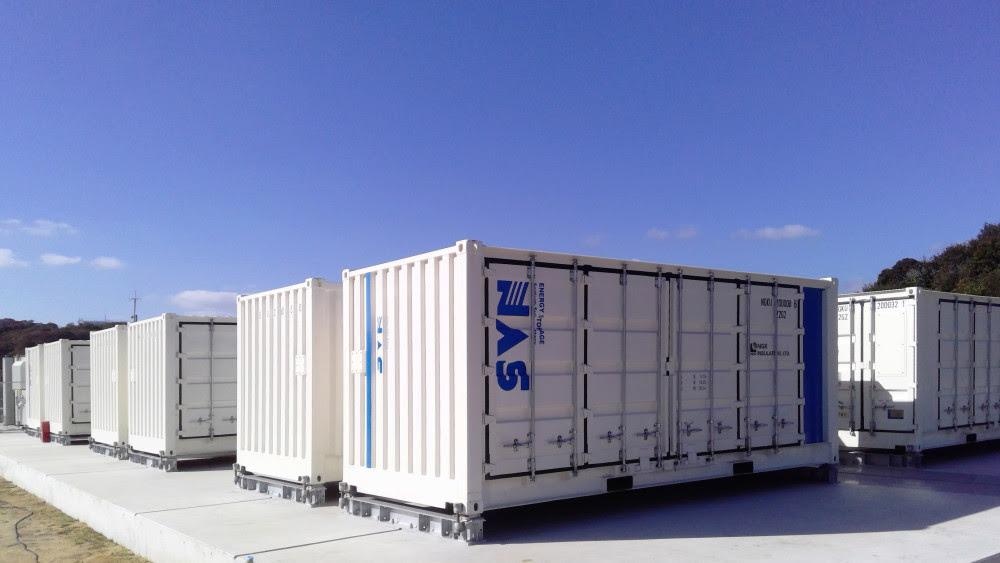NGK INSULATORS, LTD. based in Nagoya, Japan, announced that it has won an order for NAS batteries for storing electrical energy for the Tanegashima Space Center of the Japan Aerospace Exploration Agency. The order was received from Kyudenko Corporation, which is headquartered in Fukuoka, Japan.
 NAS batteries installed at the Tanegashima Space Center. Image Credit: NGK Insulators, Ltd
NAS batteries installed at the Tanegashima Space Center. Image Credit: NGK Insulators, Ltd
In order to ensure the reliable launch of main launch vehicles from Tanegashima Space Center, JAXA is currently undertaking various initiatives, such as installing large-scale storage battery systems, to further improve the reliability of its electric power systems. NAS batteries, which have a large capacity, were evaluated as being well suited to building the electrical infrastructure of the launch complex. This evaluation was based on the large number of NAS batteries installed to date and their reliability, which is supported by a long-term operational track record, in addition to their capacity (discharge time), environmental tolerance, and lifecycle cost. For these reasons, NAS batteries were approved for adoption at the Tanegashima Space Center.
NAS batteries will be used for the following applications:
1. Emergency backup power source (backup power supply for electrical generators)
At the Tanegashima Space Center, several electrical generators are in operation 24 hours a day, 365 days a year in order to ensure a steady supply of electric power for launch operations and to facilitate business continuity planning (BCP) for natural disasters such as lightning strikes or typhoons. In the event of a malfunction of the electrical generators, the facility will be supplied with backup power from the NAS batteries. The combination of the electrical generators and large-capacity NAS batteries will realize an even more stable supply of electric power.
2. Frequency stabilization (Improve the quality of electric power)
Fluctuations in the electric power load that cannot be tracked by the electrical generators will be absorbed through the charging and discharging of the NAS batteries, thereby suppressing fluctuations in the electrical frequency and enhancing the quality of electric power.
3. Energy conservation through the highly efficient operation of electrical generators
The efficiency of electrical generators can be enhanced through the continuous operation of the electrical generators at a constant output. When electricity usage is less than the amount of electricity generated by the electrical generators, the surplus electricity will be used to charge the NAS batteries. When electricity usage is greater than the amount of electricity generated by the electrical generators, the NAS batteries will be discharged to level out the electric power load. These processes will maintain highly efficient operation of the electrical generators, thereby realizing reductions in the use of fossil fuels and the amount of carbon dioxide (CO2) emissions. In addition, NAS batteries have a large capacity and can be operated for a long duration, so they will also help to reduce the number of electrical generators in operation.
Since their commercialization in 2002, NGK has installed NAS batteries in over 200 locations worldwide, with a total output of over 600,000 kilowatts (600 megawatts) and a total storage capacity of over 4.2 million kilowatt-hours (4,200 megawatt-hours). Another feature of NAS batteries is that they offer a long life expectancy of 15 years. At several facilities, NAS batteries have already been renewed after 15 years of successful commercial operation. Going forward, NGK will continue to push ahead with proposal and sales activities for NAS batteries, which will be offered as large-capacity storage batteries with an extensive track record. In the process, NGK will support the stable supply and efficient use of electric power and contribute to the lowering of energy costs, reduction of environmental impact, and formation of a decarbonized society.
Summary of order received for NAS batteries
Installation site: Tanegashima Space Center (Minamitane-cho, Kumage-gun, Kagoshima)
Rated output: 2,400 kilowatts
Rated capacity: 14,400 kilowatt-hours
Applications: Emergency backup power source, frequency stabilization, highly efficient operation of electrical generators
Start of operation: April 2021 (planned)